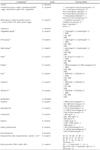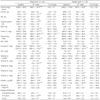1. Burke GL, Bertoni AG, Shea S, Tracy R, Watson KE, Blumenthal RS, Chung H, Carnethon MR. The impact of obesity on cardiovascular disease risk factors and subclinical vascular disease: the Multi-Ethnic Study of Atherosclerosis. Arch Intern Med. 2008. 168(9):928–935.

2. James PT, Rigby N, Leach R. The obesity epidemic, metabolic syndrome and future prevention strategies. International Obesity Task Force. Eur J Cardiovasc Prev Rehabil. 2004. 11(1):3–8.

3. Ascaso JF, Romero P, Real JT, Lorente RI, Martinez-Valls J, Carmena R. Abdominal obesity, insulin resistance, and metabolic syndrome in a southern European population. Eur J Intern Med. 2003. 14:101–106.

4. Hill MJ, Metcalfe D, McTernan PG. Obesity and diabetes: lipids, 'nowhere to run to'. Clin Sci. 2009. 116(2):113–123.

5. Norris SL, Zhang X, Avenell A, Gregg E, Schmid CH, Kim C, Lau J. Efficacy of pharmacotherapy for weight loss in adults with type 2 diabetes mellitus: a meta-analysis. Arch Intern Med. 2004. 164(13):1395–1404.

6. Moon HK, Lee HJ, Park Y. Comparison of health status and dietary habits by percent body fat (PBF) change for adult women in the weight control program by the community health center. Korean J Community Nutr. 2007. 12(4):477–488.
7. Matuschka P. Diebetes and 'normal' lifestyle. Am Fam Physician. 1995. 52(7):2011–2012.
8. Park JA, Yoon JS. Dietary behaviors and status of nutrient intakes by the obesity levels of housewives in Daegu. Korean J Community Nutr. 2005. 10(5):623–632.
9. Yi KO, Kim JY, Kim WY. Effects of obesity treatment program. J Korean Aerobic Exerc. 2001. 5(1):69–84.
10. Jeon ER. Effect of nutrition education and aerobic exercise program on weight control program of middle aged abdominal obese women. Korean J Human Ecology. 2006. 9(2):65–73.
11. Lee KW. The effects of obesity management program on body composition and blood lipids profile in obese female collegiate students. J Sport Leisure Studies. 2001. 15:663–339.
12. Seo JH. Evaluation of weight control program for obese female college students. J Korean Soc Food Sci Nutr. 2005. 24(9):1381–1387.
13. McArdle W, Katch F, Katch V. Exercise Physiology: Energy Nutrition and Human Performance. 1996. Fourth edition. Williams & Wilkins Pub;603–630.
14. Yu OK, Cha YS. A comparative study on dietary life according to the obesity assessment methods of higher grade elementary school students in Jeonju. Korean J Human Ecology. 2006. 9(4):83–93.
15. Lee YA, Kim KN, Chang NS. The effect of nutrition education on weight control and diet quality in middle-aged women. Korean J Nutr. 2008. 41(1):54–64.
16. Ledikwe JH, Rolls BJ, Diane HS, Mitchell DC, Ard JD, Champagne C, Karanja N, Lin PH, Stevens VJ, Appel LJ. Reduction in dietary energy density are associated with weight loss in overweight and obese participants in the PREMIER trial. Am J Clin Nutr. 2007. 85:1212–1221.

17. Oh KW, Nam CM, Park JH, Yoon JY. A case-control study on dietary quality and risk for coronary heart disease in Korean men. Korean J Nutr. 2003. 36(6):613–621.
18. Lee SH, Chang NS. Effectiveness of nutrition education on dietary habits and diet quality in the weight loss and weight gain groups in college women. Korean J Nutr. 2007. 40(5):463–474.
19. Brinkworth GD, Noakes M, Keogh JB, Luscombe ND, Wittert GA, Clifton PM. Long-term effects of a high-protein, low-carbohydrate diet on weight control and cardiovascular risk markers in obese hyperinsulinemic subjects. Intern J Obes. 2004. 28:661–670.

20. Aleixandre A, Miguel M. Dietary fiber in the prevention and treatment of metabolic syndrome: a review. Crit Rev Food Sci Nutr. 2008. 48(10):905–912.

21. Duvigneaud N, Wijndaele K, Matton L, Philippaerts R, Lefevre J, Thomis M, Delecluse C, Duquet W. Dietary factors associated with obesity indicators and level of sports participation in Flemish adults: a cross-sectional study. Nutr J. 2007. 6:26.

22. Kim HJ, Kim SN, Kim S. Effects of diet-records on body composition and calorie intake in obese school girls. Korean J Physical Edu. 2005. 44(6):567–577.
23. Friewald WT, Levy RI, Fredrickson DS. Estimation of the concentration of low-density lipoprotein cholesterol in plasma without use of the preparative ultracentrifuge. Clin Chem. 1972. 18:499–502.

24. Lauer RM, Clarke WP, Lee J. Factors affecting the relationship between childhood and adult cholesterol levels. Pediatrics. 1988. 82:309–318.
25. The Korean Nutrition Society. Dietary Reference Intakes for Koreans. 2005. Seoul:
26. Kim S, Haines PS, Siega-Riz AM, Popkin BM. The Diet Quality Index-International (DQI-I) provides an effective tool for cross-national comparison of diet quality as illustrated by China and the United States. J Nutr. 2003. 133:3476–3483.

27. Korean Society for Lipid and Atherosclerosis. Korean Guidelines of Hyperlipidemia Treatment for Prevention of Atherosclerosis. 2002.
28. Drewnowski A. Concept of a nutritious food: toward a nutrient density score. Am J Clin Nutr. 2005. 82(4):721–732.

29. Inoue S, Zimmet P, Caterson I, Chunming C, Ikeda Y, Kim YS, Bassett J. The Asia-pacific perspective: redefining obesity and its treatment. 2000. The International Diabetes Institute.
30. Lee HJ. Evaluation of multilateral weight control program for female college students by follow-up search [dissertation]. 2005. Seoul: Ewha Womans University Graduate School.
31. Lee JS, Park JS, Lee GH, Ko YS, Kim EK. Effect of body composition, serum lipid level, and resting metabolic rate by nutritional education and exercise program in middle aged women. J Korean Dietetic Assoc. 2008. 14(1):64–76.
32. Stern L, Iqbal N, Seshadri P, Chicano KL, Daily DA, McGrory J. The effects of low-carbohydrate versus conventional weight loss diets in severely obese adults: one-year follow-up of a randomized trial. Ann Intern Med. 2004. 140:778–785.

33. Daubenmier JJ, Weidner G, Sumner MD, Mendell N, Merritt-Worden T, Studley J, Ornish D. The contribution of changes in diet, exercise, and stress management to changes in coronary risk in women and men in the multisite cardiac lifestyle intervention program. Ann Behav Med. 2007. 33(1):57–68.

34. Kang YH, Lee KO, Ha EH, Kim JY, Kim WY. Evaluation of short term weight control program for female college students. Korean J Nutr. 2004. 37(6):493–501.
35. Lee JS, Lee HO, Yim JE, Kim YS, Choue RW. Effects of medical nutrition therapy on changes of anthropometric measurements, dietary pattern and blood parameters in over weight or obese women. Korean J Nutr. 2005. 38(6):432–444.
36. Quatromoni PA, Pencina M, Cobain MR, Jacques PF, D'Agostino RB. Dietary quality predicts adult weight gain: Findings from the Framingham Offspring Study. Obesity. 2006. 14(8):1383–1391.











 PDF
PDF ePub
ePub Citation
Citation Print
Print


 XML Download
XML Download